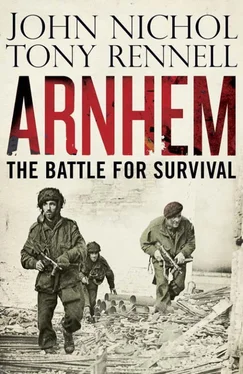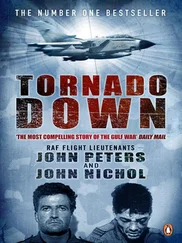By now, the main force was on its way to Arnhem, heading out over the Suffolk coast at Aldeburgh and due east across the North Sea. At the same time, a separate stream was passing over Kent and the English Channel with the American airborne divisions en route to Eindhoven and Nijmegen. In all the subsequent inquests into what went wrong with the mission, the triumph of logistics in getting this huge armada – the ‘Market’ part of Market Garden – assembled in the air was often overlooked. [6] ‘Market’ was the codename for the airlift part of the operation and ‘Garden’ the codename for the land operation. Hence the operation as a whole was ‘Market Garden’.
An airborne operation of this magnitude – three thousand aircraft over two days – had never been attempted before, not in North Africa, Sicily, Italy, not in Normandy. It took meticulous flight planning – take-off time, route, height, speed, and so on – to get each plane to its rendezvous point. Iron discipline was then needed to move this vast swarm in the same direction without planes knocking each other out of the sky. The sheer numbers took away the breath of those who witnessed it, whether Sunday worshippers down below returning home from church, or people on their way to the pub and looking up in awe from the ground, or those in the air right in the middle of it all. At home in Essex, a fourteen-year-old schoolboy leaned out of an upstairs window and checked off the Dakotas, Stirlings, Horsas and Hamilcars against an aircraft recognition chart on his bedroom wall. ‘It was the most wonderful sight I had ever seen, a never-ending stream of planes and gliders.’ Though he cannot have known what mission they were embarked on, he remembered thinking, ‘Jerry’s going to get a real pasting. That’s it. This lot will win us the war!’ [7] Quoted in Arnhem , by Lloyd Clark. Headline, 2009.
Reg Curtis was one of those up there and, like the vast majority of those jumping that day, in an American Dakota, which was much more comfortable than the RAF planes that Kent and his pathfinder paras had travelled in. It had benches to sit on rather than the cold metal of the floor and porthole views of the skies around them as they circled around for an hour manoeuvring into the mass formation. He was inspired. ‘I have never seen so many planes in the air at one time. And not just transporters but Typhoons, Spitfires and Mustangs weaving between us, as protection against enemy fighters. I wondered where the heck all these men and machines had come from. It was a far cry from the Dunkirk days when we had no paras and were lucky to scrape up a few fighter planes.’ Ted Mordecai, flying in the heart of this ‘mighty air armada’, felt the planes were so close that if he stretched out his hand he could almost touch the wing of the nearest one. [8] Ted Mordecai. Private memoir. Airborne Ordnance at Arnhem, Airborne Assault, Imperial War Museum, Duxford.
The sheer weight of numbers swelled his confidence.
Others on that journey were less enthusiastic. Seeing the sun shining off the clouds, James Sims felt he was in heaven, the view was so beautiful, but the thoughts inside his head were far from serene. ‘What if we ran into flak or enemy fighters? And even if we got safely to the other side, what German reception committee was waiting for us? Cannon fire? Machine guns? Tanks? Cold steel? “What the hell am I doing here?” I asked myself. “I must be bloody mad!”’ A glance around the aircraft at the coolness of his comrades was reassuring, though he was almost certainly not alone in his sense of dread. To distract himself he buried his head in a copy of the Reader’s Digest but then his mind wandered to the ‘cocktail’ of comrades-in-arms seated beside him – ‘English, Irish, Scots and Welsh, Geordies, Scousers, Cockneys, men from the Midlands, men from Cambridge, Kent and Sussex. Some of us had been shop assistants, others salesmen, farmers, and barrow boys. There was even a poacher.’ But where they had come from was irrelevant now. Only the immediate future mattered, where they were going and what they would do when they got there.
‘Nearing the Dutch coast, we were warned to brace ourselves as the aircraft dived down through the clouds to about 2,000 feet.’ Stomachs churned. ‘From below a German naval vessel opened fire at us with a machine gun. The pilot took instant evasive action and the plane banked alarmingly. We watched fascinated as a stream of tracer bullets arched towards us, whipping past the open doorway like angry hornets. Some of our fighter escort peeled off and swept down to attack the German vessel, which vanished in a storm of rocket fire. We were undamaged and quickly resumed our position in the armada, but quite a number of us had to make use of the brown paper bags issued for sickness. Fancy giving people bacon sandwiches before take-off!’
Now, those who dared to look out could see Holland below and, ahead of them, the route to Arnhem marked out by blazing anti-aircraft-gun emplacements taken out by the fighters and low-level bombers. Time to go. As they stood up and edged towards the exit, a wisecracker called out ‘Pass right down the bus, please!’, but any laughter was now stifled by the rushing wind outside as they dropped to 700 feet for the run-in. Etched in Sims’s memory would be the split-second sight of his platoon commander, Lieutenant Woods, standing framed in the doorway, ‘the slipstream plucking impatiently at the scrim netting on his helmet’, before he was gone. Sims went too and ‘found myself in the middle of a blizzard of silk. I was exhilarated, conscious of taking part in one of the greatest airborne descents in the history of warfare.’ In his plane, Reg Curtis, a veteran of North Africa, Sicily and Italy, felt a slight pat on his back and then he too tumbled out of the doorway ‘into that familiar open void again. My chute once more obediently opened.’
Down on the ground, Ron Kent heard the murmur of aircraft engines away to the south, turning to a steady low roar, and snapped back into action. ‘Wave after wave of transport planes came into sight. I had never seen so many low-flying aircraft in a single formation before. I could see gliders among the armada, black, long-nosed Horsas, which began to cast off, turn gracefully, then dive at incredibly steep angles. They were beautiful to watch but what really caught the eye was the spectacle of the mass parachute drop directly over us as the sky blossomed forth with flower-like patterns, brilliant in the sunlight.’ To a puzzled German artillery officer who happened to glance out of the window at his unit’s base in a school in Arnhem, it seemed at first that, in the distance, snowflakes were falling from the sky. Then he realized that ‘it never snows in September. They must be parachutists.’ [9] It Never Snows in September , by Robert Kershaw. Ian Allan, 2009.
Whatever they looked like, whether ‘flowers’ or ‘snowflakes’, the men arriving were more like a whirlwind or a dust storm. As they fell, they called out to each other, coordinating their descents with the usual banter of an elite corps, then hit the ground, gathered up their parachutes and marched to the edge of the drop zone to re-form into their platoons and companies. For Reg Curtis it suddenly hit home that he was now actually behind the lines, in enemy-occupied territory. But he was reassured as he looked around at the busy, purposeful chaos of the landing site. Until moments before it had been just a deserted piece of anonymous Dutch countryside. Now it teemed ‘like a giant crossroads, with jeeps calmly bouncing over the ploughed earth, gliders coming in to land like an inter-city air service, soldiers collecting equipment from containers, then sprinting off sharply to join up with their units, earmarked by various coloured smoke canisters.’
Читать дальше












